How voice search is the new frontier of content marketing

Posted by Lisa Sills
March 22nd, 2017
In Her, Spike Jonze’s hipster-tinged Oscar winner, Joaquin Phoenix falls desperately in love with Samantha, an intelligent computer operating system.
At the end of the film (spoiler alert!), Samantha leaves Phoenix’s Theodore because operating systems have evolved beyond their human companions and are leaving to explore their existence. In essence, Theodore falls head over heels for a very advanced voice search.
It’s a bit sad, really, if you think about it – but it makes for an interesting film and a somewhat beleaguered glimpse into the potential future of voice search. And sure, voice search isn’t about to go rogue (and sentient), but right now, it’s the new – and interesting – frontier for content marketers.
Voice search: a history
Google Voice Search was conceived as one of Google Labs’ many experiments. The tech has been around since 2010 when users had to call out a phone number to trigger voice search.
Much like today, Google would return searches relevant to the query. As with everything in the earlier days of the mobile era, it was clunky and inelegant – but it was a start.
Since then, Google has worked to integrate voice search with better tech, most notably its virtual assistant Google Now. The arena of personal assistants is where the true power of voice search lies – and likely where much of the innovation will come.
The growth of voice search
In 2013, the head of Google’s search rankings team, Amit Singhal, is famously on record as saying that, “the destiny of Google’s search engine is to become that Star Trek computer, and that’s what we are building.” That was at SXSW 2013.
Flash forward to 2017 and those intervening four years have created a hugely interesting environment for voice search. Google CEO Sundar Pichai announced in 2016 that 20 percent of queries made in the US on its mobile app and on Android are now through voice.
MindMeld carried out a survey that found that 60 percent of their survey respondents had started using virtual assistants and voice search in the past 12 months.
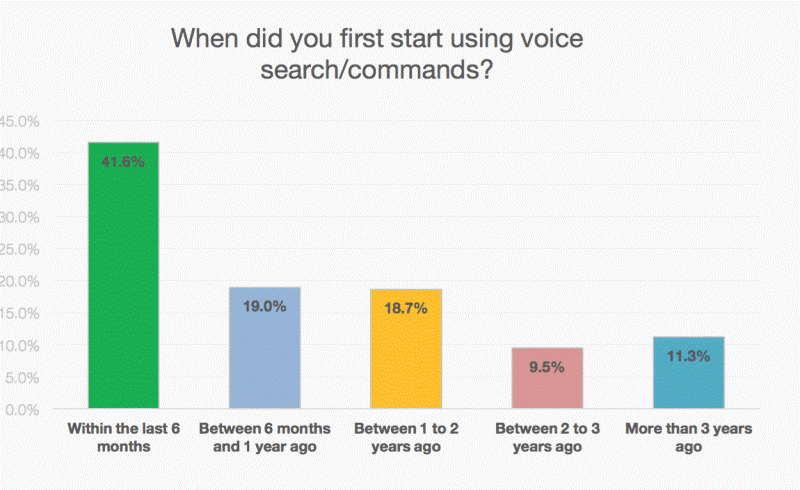
When we think of search and making queries, it’s easy to go straight to the typical method: mobile phone in hand. But marketers need to think wider; we need to keep one eye on the future and on virtual assistants.
Amazon’s Alexa already allows users to order Domino’s or an Uber – but it doesn’t do too well in Ireland so far. Google is steadily integrating more third-party apps into Google Home, such as Uber, WhatsApp, and Ticketmaster.
Where voice search was conversational in Her, the reality of the situation is that it’s steadily becoming both more conversational and transactional as voice/personal assistant apps race to conquer their corner of the market.
Naturally, this evolution will have an impact on content marketing and SEO.
How voice search will affect content marketing
Trend watcher Mary Meeker carries out an annual Internet Trends Report. Her 2016 report delved into voice search and why people use it. As with all things content marketing, the ‘why’ is imperative to creating content that works.
As per her study, the primary reason people use search is because it’s useful when their hands or vision are occupied (think driving in the car or pottering around the house). Unsurprisingly, at home and in the car represented 80 percent of voice usage. That number is likely to fluctuate, but minimally – especially with the continued rise of smart homes and virtual assistants.
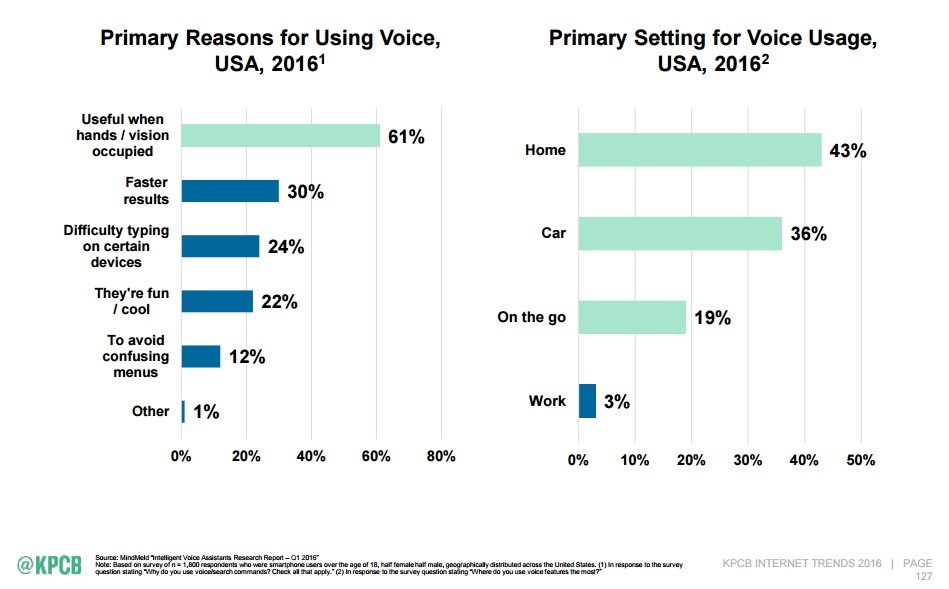
A curious interloper of this rise has been the lateral growth of Bing. Where Google dominates traditional search, Microsoft has made the very smart move of aligning with Apple and Amazon to power their voice search apps. Google Voice, then, is powered by Google searches.
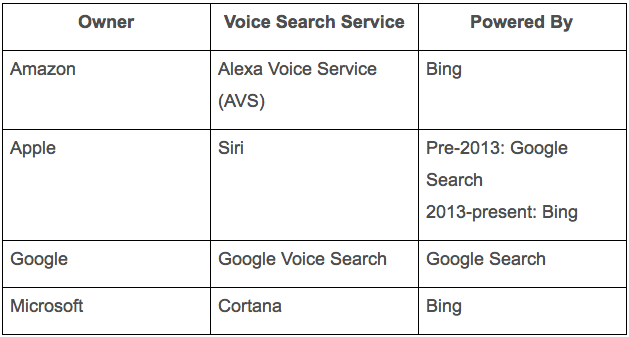
Voice search represents a unique challenge for content marketers. In its simplest form, it breaks into a strict brief of ‘objectives’, ‘challenges’, and ‘solutions’.
Objectives
- Create content that will rank highly in voice searches results.
- Identify the voice and conversational style of your customers.
Challenges
- Recognise how people will search by voice e.g. what devices, when, why, the semantics of it.
- Recognise what they will search for and how they will phrase it.
- Allow for tone variants in different markets e.g. business settings versus something more colloquial.
- Optimise websites for voice search.
- Create content that will apply both to traditional search and voice search.
Solutions
- Ensure websites are optimised for voice and traditional search.
- Engage with analytics to understand the different types of searches.
- Add tags and update analytics to include for where people are searching from, as 'near me' will be increasingly popular for voice search.
- Pay continued attention to long-tail and conversational terms.
- Think about where people will use voice search e.g. in the car, when cooking, etc.
- Create ‘question and answer’ style articles that allow for questions and terms in a conversational tone.
The big difference between traditional and voice is in the semantics of the phrase. While typing, most users utilise speed and may not even include core wording or stop phrases. It’s not unusual, then, for misspellings to pop up as a keyword worth targeting in Keyword Planner.
Let’s look at a simple search to illustrate the differences. For this example, we’re dealing with the wedding vertical.
A would-be-bride might Google ‘wedding planning’ on their phone. On voice, they might ask a completed sentence:

The language of voice is different insofar as it’s conversational – it’s natural, especially if you’re in your car or at home. While out and about, you’ll likely type a query or ask a short question but in the comfort of your own company, your search will mark your intent while still ultimately being conversational.
Traditional search has moved towards a more personalised web browsing experience by combining disparate services for a unique browsing experience. Marketing to people is the norm with advertisers targeting a small subset based on who they are beyond their demographics. With the advent of digital, it’s not about ‘male, 24-40’ anymore.
It’s possible then that voice search may play an integral part in the evolution of digital advertising. Presuming you’re signed into Google and allow for tracking, Google comes to learn who you are. It has hordes of data on you, taken from your browsing patterns, the sites you’ve visited, your web history, and your site history - it even knows where you live and the places you visit most often.
Likely, Google could create an algorithm to build a reasonably accurate profile of every one of its users: your likes, your dislikes, your preferences, and a sample of your personhood.

The same will (and can) apply to voice and the patterns of speech. Ask 10 people to make a search about the same topic and they’ll each word it slightly differently to allow for colloquialisms and personality.
Google’s long game is to provide the answers to queries. It’s evident too in the prediction of eventual queryless search (which we wrote about here) and the mastery of a refined personal assistant. There’s a reason every major company has made a play in the personal assistant game, after all.
How to optimise your content for voice search
Voice search is a major player in content marketing. And sure, it may take a couple of years to see the true boon – but the brands who react fastest (and best) are the brands who will prosper in the post-voice search age.
Think into the future. You can optimise for now or you can optimise for five years’ time. Voice search may have a reasonably small pick-up now, but what happens when smart tech and personal assistants make their way into most homes in the developing world? The technology is burgeoning, but in 2025 (or sooner) it could be endemic.
As marketers, we need to optimise for that.
1. The march of mobile
Mobile search eclipsed desktop for the first time in early 2015. Since then, mobile has become the crux of many digital strategies. While mobile-first isn’t the way to go (mobile hasn’t replaced desktop, as it were), optimising for mobile-friendly content is absolutely the way forward – especially in the realm of voice search.
In brief, mobile content should:
- Embrace visuals.
- Focus on localised content and geo-tagging.
- Keep multi-channel in mind.
- Be smart about content formatting.
- Be responsive on all channels/platforms.
As a final pro-tip: If you’re running Adwords campaigns, capitalise on the locations extension.
2. Conversational keywords
Hummingbird and latent semantic indexing have long spelled the death of exact-match keywords. Google is smart. Let’s say you Google ‘punctured tire’.
Instead of delivering a rote series of results about what a punctured tire is, you get a useful stream of content:
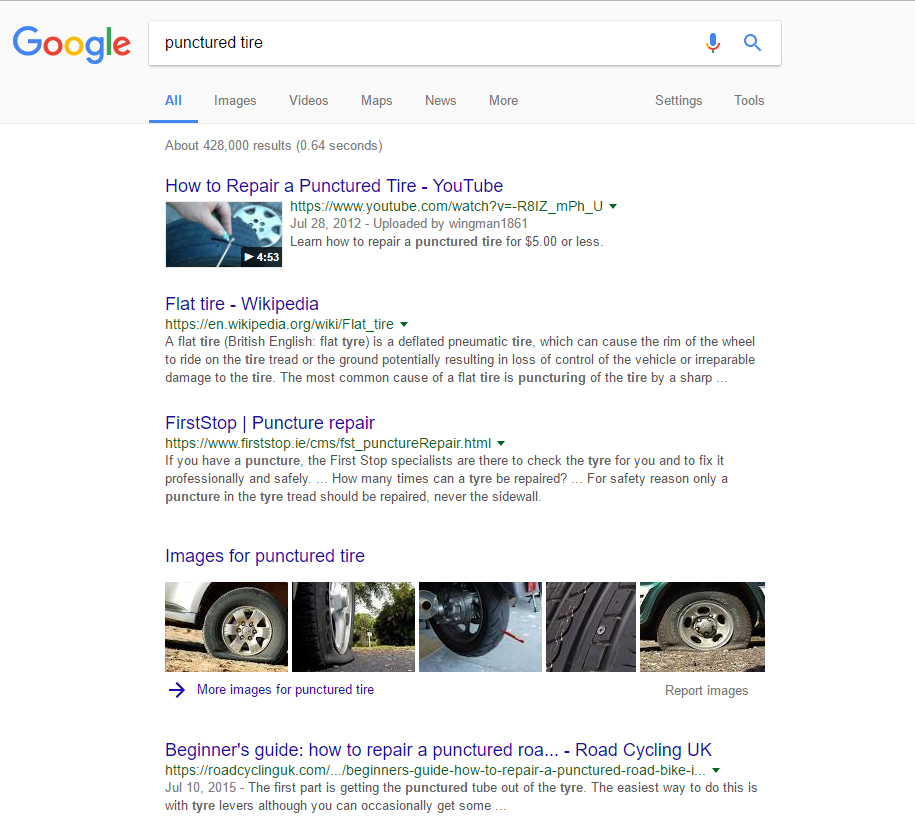
Voice signals a further trend in this direction. Content needs to be conversational – and smarter. Voice queries may well be less succinct, but they also may include for human error. Who is to say that someone won’t find your content by asking something like “Okay Google! What is a good app for doing things more efficiently?”
Where they may have searched ‘productivity app’ on their device, they’ve blown the search market open with a broader query.
Your content will need to answer this question; your headlines will be even more important too. Put yourself in your audience’s shoes and use those insights to fuel your content.
3. Manage moments
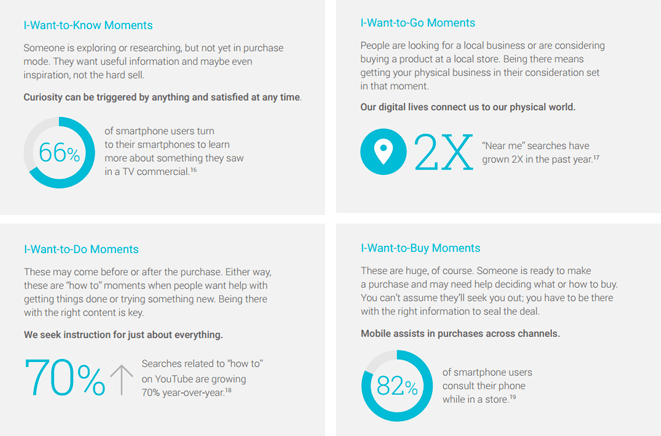
What is this graphic? It’s Google’s four subsets of ‘micro-moments’:
- I-Want-to-Know Moments: Where someone is researching something (often at the bottom of the funnel).
- I-Want-to-Go Moments: Essentially, these are ‘near me’ phrases where people are looking for restaurants or shops or businesses nearby. The rules of local search apply most strongly here.
- I-Want-to-Do Moments: A singular emphasis here on ‘how-to’ content.
- I-Want-to-Buy Moments: Users searching either for a physical store to shop in, or for a ‘clicks and mortar’ ecommerce brand to buy from.
A savvy content marketer will allow for each of these four micro-moments and use them to align their content to their buyer journey (aka content mapping).
While voice search is still in its infancy, savvy marketers will take the time to fill the gap in the market. Sure, you can wait until voice search blows up (and possibly goes sentient if Her is anything to go by), but smart digital is often complimented by speed.
Get there first and your competitors will struggle to catch up. To be truly efficient, marketers must constantly be looking forward. Like Samantha, the AI object of affection in Her said: “The past is just a story we tell ourselves.”
And no content marketer wants their content to belong to the past.

Lisa Sills

Previous Post
Get them hooked: Why content marketing is vital for your digital marketing strategy
Next Post

5 step guide to setting up buyer personas for your marketing strategy
Subscribe Here
You may also like...
Nicole Thomsen | Dec 11, 2023
Nicole Thomsen | Nov 6, 2023
Nadia Reckmann | Nov 2, 2023





